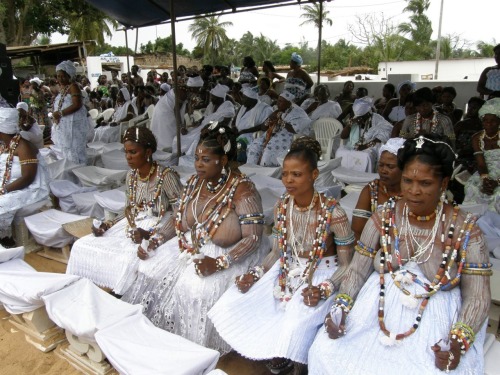Starting in the 16th century, large numbers of Yoruba natives were transported as slaves to the Caribbean and the Americas. They combined beliefs and practices from their Ifa religion with elements of Roman Catholicism to produce the syncretistic religions of Candomblé, Palo Mayombe, Santeria, Vodun, etc. These are now flourishing in the Caribbean, South America and North America, notably in Brazil, Colombia, Cuba, Grenada, the Guyanas, Jamaica, Puerto Rico, St. Kitts, St. Vincent, Tobago, and Trinidad.http://www.religioustolerance.org/ifa.htm
In their mind everything African is chained to slavery,never mind there were always African populations in the Caribbean and S.America dating from ancient times.
Ifa,and its derivatives are actually extremely complicated with extensive pantheons and detailed requirements of its devotees and practitioners. However they all share certain main themes
- Prominence of female priests
- Ritual music and dance
- exorcism
- Human and Animal sacrifice
- execration ritual
- Belief in spirits
- Ancestor Veneration
"You could see the mouth and eyes of the snake. It looked like a real python," said Sheila Coulson of the University of Oslo. "The play of sunlight over the indentations gave them the appearance of snake skin. At night, the firelight gave one the feeling that the snake was actually moving."
From the wall of Apep.
Cotzolcoatl,the feathered serpent of the Aztecs is a direct product of the ancient African religious concept of the snake and ideas of death and rebirth.
Snakes,particularly pythons are still an important part of modern voodoo.
Beninese voodoo priestesses.
A typical S.Indian carving of the snake gods.
Krishna dancing on the kaliya serpent.
The god Shiva,king of all nagas.
3000 year old Afro Minoan carving of the female snake motiff.Yes,Africans were also there!
This religion morphed into the Nile Valley faiths and even Hinduism. Even a casual glance will show the same elements apart from female priestesses which died out as the Turkic Caucasoids introduced patriarchy in their society as they spread out from the Central Asian homeland.









